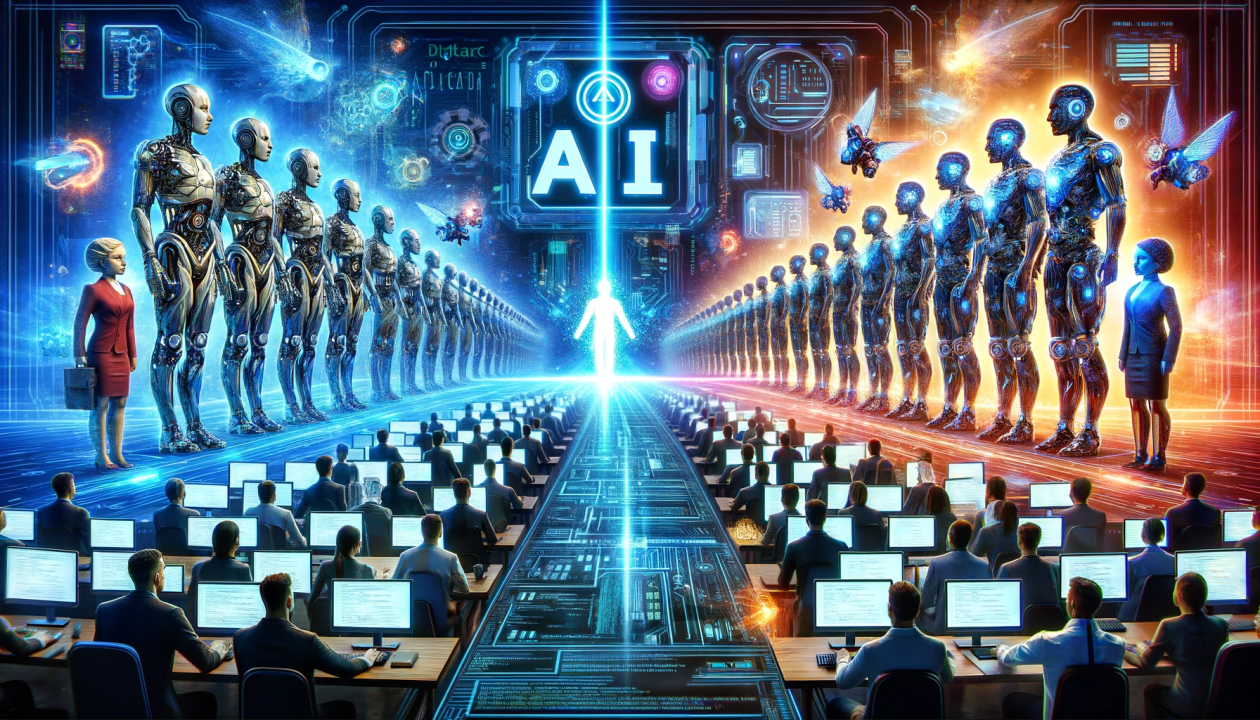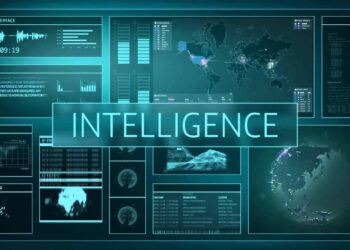Artificial Intelligence (AI) is no longer a niche technology; it is the fundamental engine driving the next wave of technological and economic supremacy. The current landscape is defined by an intense, multi-billion-dollar race where tech giants including Google, Microsoft, Meta, and Amazon, among others—are fiercely competing for dominance.
This isn’t merely a competition for market share; it’s a battle for control over the intellectual infrastructure of the future, a domain where the winner dictates the evolution of nearly every industry, from healthcare and finance to transportation and creative arts.
The stakes are astronomically high. Owning the leading AI models, the most comprehensive data sets, and the most sophisticated AI talent provides an almost insurmountable competitive advantage. These large language models (LLMs) and generative AI systems are rapidly transforming how information is created, consumed, and monetized.
Companies recognize that AI Supremacy translates directly into massive recurring revenue streams, unparalleled operational efficiency, and a near-monopoly on future innovation.
This article delves into the core components of this monumental struggle: the massive capital investment, the technological breakthroughs, the strategic acquisitions, and the ethical dilemmas that define the modern AI battleground. Understanding the strategies deployed by these tech titans is crucial for anyone looking to navigate the swiftly evolving digital economy.
Defining the Battleground: Generative AI and Large Language Models (LLMs)
The current focus of the AI battle centers on Generative AI—systems capable of creating new content, including text, images, code, and video, that is often indistinguishable from human-made work. The backbone of this revolution is the Large Language Model (LLM), a deep learning model trained on vast amounts of data, enabling it to understand, summarize, generate, and predict human language with remarkable accuracy.
- Foundation Models (FMs): These are the massive, general-purpose models (like OpenAI’s GPT series or Google’s Gemini) trained on an enormous scale. They serve as the foundation upon which more specific AI applications are built, giving their creators significant control over the entire application ecosystem.
- Contextual Understanding: LLMs are increasingly sophisticated at grasping nuance, context, and intent, allowing for more helpful and less robotic interactions across various applications, including search engines and virtual assistants.
- Multimodality: The newest generation of AI models can process and generate across multiple data types—text, images, audio, and code—simultaneously. This integration vastly expands the potential use cases, moving AI beyond simple text generation.
- Scaling Laws and Data Dominance: The performance of these models often scales predictably with the amount of data, the model size (parameters), and the computational power used for training. This means that the companies with the most data and the deepest pockets have an inherent advantage.
The Titans and Their Core Strategies
The competition among tech giants is characterized by distinct strategic approaches, each leveraging the company’s unique strengths, be it search dominance, cloud infrastructure, or social network data.
1. Google (Alphabet): The Defensive Pioneer
Google, a pioneer in deep learning with its revolutionary Transformer architecture (the foundation for virtually all modern LLMs), is now fighting to defend its lucrative search monopoly from AI-driven disruption.
- Unifying AI Initiatives: Google has integrated its AI research division, DeepMind, with its core product development teams to accelerate the deployment of advanced models like Gemini (their latest multimodal model) across all their products, including Search, Workspace, and Android.
- AI-Powered Search (SGE): The primary strategic goal is to embed generative AI directly into search results via the Search Generative Experience (SGE). This aims to provide direct, comprehensive answers and summaries, thus keeping users within the Google ecosystem rather than directing them to external websites.
- Cloud AI Services (Vertex AI): Google Cloud offers a comprehensive suite of AI tools and services, including access to their foundational models, enabling enterprise clients to build their own custom AI applications. This strategy leverages their robust data center network to monetize AI development.
- Robotics and Physical AI: Beyond digital models, Google continues to invest heavily in robotics and physical world AI, seeking to integrate intelligent systems into real-world applications and hardware.
2. Microsoft and OpenAI: The Aggressive Challenger
Microsoft’s strategy is perhaps the most aggressive and market-disrupting. By investing billions in OpenAI (creators of ChatGPT and GPT models), Microsoft secured an exclusive and deep technological partnership.
- Strategic Integration with Azure: Microsoft utilizes its vast Azure cloud computing platform to power OpenAI’s models. This relationship is mutually beneficial: OpenAI gets essential computing resources, and Microsoft attracts countless enterprise customers seeking to deploy the most advanced AI via Azure AI Services.
- Reimagining Productivity (Copilots): Microsoft is embedding AI assistants, branded as “Copilots,” into its entire product stack, including Windows, Office 365 (Word, Excel, PowerPoint), GitHub, and Dynamics 365. This strategy transforms existing tools into highly efficient, AI-augmented services, cementing its dominance in the enterprise software market.
- Challenging Search with Bing and ChatGPT: The integration of GPT-4 into Microsoft Bing was a direct challenge to Google’s search dominance, positioning Bing as a more conversational and context-aware alternative.
- Hardware and Edge AI: Investing in custom AI chips and edge computing capabilities to optimize the performance of its models on user devices.
3. Meta (Facebook): The Open-Source Advocate
Meta’s strategy centers on leveraging its massive social network data and adopting an open-source approach to democratize its foundational models, notably the Llama series.
- Open-Source LLMs: By making its Llama models available to the research community and businesses, Meta hopes to foster a massive ecosystem of developers building on its technology. This could lead to Llama becoming the industry standard, even if Meta doesn’t directly charge for the model itself.
- Metaverse and Generative AI: AI is crucial to Meta’s long-term vision for the Metaverse, driving realistic avatar creation, advanced non-player characters (NPCs), and real-time world generation.
- AI for Content Moderation and Recommendation: Leveraging its immense trove of user data, Meta uses AI to enhance its content recommendation algorithms (keeping users engaged on Instagram and Facebook) and to improve content moderation efforts globally.
4. Amazon: The Infrastructure and Commerce Leader
Amazon, leveraging its dominant position in cloud computing and e-commerce, focuses on providing the tools and infrastructure for others to build AI, rather than focusing solely on a single, consumer-facing LLM.
- AWS Bedrock: Amazon Web Services (AWS) launched Bedrock, a fully managed service that offers access to a variety of top foundational models (FMs) from Amazon (like the Titan series) and third-party AI companies, allowing customers to easily switch between models.
- AI for E-commerce: Amazon uses proprietary AI to optimize its recommendation engines, supply chain logistics, warehouse robotics, and pricing strategies, giving it a profound operational edge in the global retail sector.
- Custom Chip Development (Trainium/Inferentia): AWS designs its own custom AI chips, Trainium (for model training) and Inferentia (for model deployment), to offer higher performance and lower cost compared to general-purpose GPUs, attracting cost-sensitive AI startups.
 The Three Pillars of AI Competition
The Three Pillars of AI Competition
The fierce competition can be categorized into three essential pillars where tech giants are investing and battling for superiority: Talent & Research, Data & Training, and Infrastructure & Hardware.
1. Talent and Research Superiority
The quality of an AI model is inextricably linked to the expertise of the people who design, train, and refine it. The “war for talent” in AI is perhaps the most critical battle.
- Acquisition of AI Startups: Tech giants frequently acquire small, innovative AI startups, not just for their technology but primarily for their engineering teams and research leadership. This “acqui-hire” strategy removes competitors while instantly boosting the acquiring company’s talent pool.
- High-Stakes Recruitment: The top AI researchers and engineers command seven-figure salaries, generous stock options, and unparalleled access to massive computing resources. Companies like Google’s DeepMind and Meta’s FAIR units act as global magnets for the world’s most innovative thinkers.
- Publication and Open Science: Leading AI labs strategically publish groundbreaking research (often via platforms like arXiv or high-profile conferences) to establish intellectual dominance, attract the best graduate students, and build an open reputation, even if core model weights remain proprietary.
2. Data and Training Monopoly
Data is the fuel of the AI revolution. The scale and quality of the training data directly determine the capability of the resulting LLM.
- Proprietary Data Moats: Companies with massive, proprietary datasets hold a distinct advantage. Google’s web index, Meta’s social graph and image library, and Amazon’s e-commerce transaction history represent vast, unique data moats that are impossible for competitors to replicate.
- Synthetic Data Generation: As public data sets become saturated, companies are increasingly investing in synthetic data—data created artificially by AI itself—to train newer models. This method helps overcome privacy issues and create highly specific, labeled data at scale.
- Feedback Loops (RLHF): Training modern LLMs requires extensive human feedback through a process called Reinforcement Learning from Human Feedback (RLHF). Companies use their millions of users (e.g., those using ChatGPT or SGE) to continuously rate, refine, and improve the model’s output, creating a powerful, self-perpetuating advantage.
3. Infrastructure and Hardware Investment
Training and running the largest foundation models demands unprecedented computing power, primarily via Graphics Processing Units (GPUs) or custom Application-Specific Integrated Circuits (ASICs).
- GPU Stockpiling: There is a global scramble to secure thousands of the most advanced GPUs (like Nvidia’s H100s). The companies that can afford and store the largest clusters of these expensive chips can train and iterate on their models faster than their rivals.
- Custom AI Silicon Development: To reduce reliance on external suppliers (like Nvidia) and to optimize performance for their specific models, companies like Google (TPUs – Tensor Processing Units) and Amazon (Trainium/Inferentia) design their own custom AI silicon. This offers a significant cost and performance advantage over the long term.
- Global Data Center Expansion: Maintaining a competitive edge requires continually expanding the global network of data centers to host the massive computational infrastructure necessary to serve AI models globally with low latency.
 The Economic and Societal Implications
The Economic and Societal Implications
The AI battle transcends commercial competition; it carries profound implications for the global economy, employment, and the very fabric of society.
1. Economic Transformation and Job Disruption
The pervasive deployment of generative AI across all business functions will inevitably cause massive economic restructuring.
- Massive Efficiency Gains: AI tools act as “super-assistants” in coding, creative design, legal research, and customer service, dramatically increasing the productivity of white-collar knowledge workers. This gain in efficiency is a primary driver of investment.
- Creation of New Roles: While many routine tasks will be automated, the demand for AI Prompt Engineers, AI Ethicists, and AI System Maintenance Specialists is rapidly increasing, signaling a shift in the nature of work, not just its reduction.
- Concentration of Wealth: The immense capital required to build and maintain leading AI models means that power and economic value will increasingly concentrate in the hands of the few tech giants capable of sustaining this competition.
2. The Critical Ethical and Regulatory Dilemma
The rapid, unregulated advancement of AI poses serious ethical risks that governments and the tech industry must address.
- Bias and Fairness in Training Data: If the vast training data sets are biased (reflecting societal prejudices based on race, gender, or geography), the resulting AI models will perpetuate and amplify that bias, leading to unfair outcomes in areas like hiring, loan applications, or judicial decisions.
- Misinformation and Deepfakes: Generative AI can create highly realistic deepfakes (synthetic images, audio, or video) at scale, posing an existential threat to democratic processes, public trust, and individual reputation.
- Intellectual Property (IP) Concerns: A massive legal battle is brewing over the use of copyrighted works (art, books, code) in the training data sets of LLMs. Determining who owns the IP of AI-generated content remains a complex, unresolved issue.
- Safety and Control: The development of increasingly powerful AI systems necessitates robust safety protocols and “red-teaming” (stress-testing models for malicious use) to prevent models from being deployed in ways that could cause significant societal harm.
3. The Future of AI Integration (The Next Horizon)
The current phase of the AI battle is merely the warm-up. The next decade will focus on deeply embedding AI into the core of human activity.
- Agentic AI: The move toward Agentic AI—systems that can perform complex, multi-step tasks autonomously (e.g., planning a trip, booking flights, drafting a full business plan)—will represent the next leap in productivity and integration.
- Pervasive AI and the Internet of Things (IoT): AI will become deeply embedded in physical devices, managing energy grids, automating smart cities, and performing diagnostics in medical equipment, making the world itself intelligent.
- AI as Scientific Accelerator: AI will continue to accelerate scientific discovery in areas like drug development, material science, and climate modeling, often discovering solutions that human researchers might miss.
The AI supremacy battle is a defining moment for modern technology. It is a winner-takes-all game driven by unprecedented capital, data scale, and technological ambition. The tech giants are not just building tools; they are building the intellectual framework for the future, ensuring this competition remains the most vital and valuable race on Earth for the foreseeable future.












